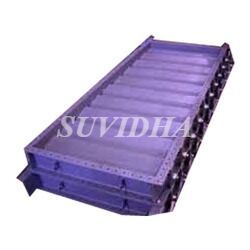
Multi Louvre Dampers
Get Price Quote
We are a global market leader in the field of manufacturing and supplying of Multi Louvre Dampers. These Multi Louvre Dampers basically perform the function of preventing the entry of air, dust or rain from the windows or gaps of any industrial setup. These Multi Louvre Dampers are increasingly finding application in the set up of various industrial processes. We are providing these Multi Louvre Dampers at affordable rates to our customers.

Multi Louver Damper
Get Price Quote
These are Motorized Multi Louver Dampers with Direct Mounted Actuator which operate in unison to offer a smooth flow control of Blower Air. These are typically suitable for Industrial applications and mounted in ducts. These units are with a sturdy sheet metal construction suitable to handle large quantities of Air and are mounted at the Suction or delivery side of combustion air blowers. The operating actuators are directly coupled to the Damper shaft. This eliminates the linkage arrangement and thus the relatively tedious linkage settings. The end limits can be set by means of adjustable limit switches inside the actuator.
Best Deals from Multi Louver Damper

multi louver dampers
Get Price Quote
Fostered with a team of experienced professionals, we have been able to manufacture and supply an exclusive range of Multi Louver Dampers. The offered dampers are manufactured from the topmost quality raw material with the help of advanced technology by our skilful professional at our premises. Our provided dampers are broadly used to stop the flow of air and widely used in air handler, chimney, ventilators, etc. In addition to this, the offered dampers can be furnished to our valuable clients at market leading prices. Features : Easy installation Less maintenance Optimum ventilation

Multi Louver Damper
Get Price Quote
Multi Louver Damper The louver type of damper consists of several blades mounted parallel across a duct, with centrally pivoted shafts extending out through a frame and driven by a linkage. Louver dampers are versatile, able in theory to handle any application in the power plant. Some of their advantages: Fit anywhere in ducting, at any altitude. Compact, no bonnet, little external clearance needed. Lightweight Drive and linkage more readily accessible Control function simple with opposed blades. Thin metal blade construction gives quick response to thermal transients. Fast opening and closing. Low leakage to outside environment. Good modulation and control characteristics. Actuation power requirements are low. Normally does not require a support structure. Louver dampers have basic disadvantages, however. Here's a partial list: Large leakage perimeter. Leakage through seals goes downstream inside the duct. Comparatively high pressure drop because of blade and seal obstruction of flow. Obstructions such as seals, shafts, stops, and fasteners tend to catch ash and scrubber slop. Inherent flimsiness of long thin blades tends to promote flutter. Blades and seals, always in the flow, tend to corrode and erode more. Blades can buckle and wrap, causing leakage and lockup. Bearing troubles are possible. Inadequate drive power and blade strength to crush through concretions and force a seal. Larger flange-to-flange required to contain blade(s) in full open position. Sealing problems in dirty applications. More moving parts and thus increased maintenance The drive for a louver are simple, needing only 90° of motion. The torque requirement can vary widely over damper life, if corrosion and thermal effects are severe. Electric motors, air cylinders, and oil cylinders are able to actuate louver dampers with little difficulty. Louver dampers are best applied to balance or control flow. The normal leak path of 0.7% of duct area produces a three to five percent leak rate in average applications. As a general rule, a damper should be used in the middle third of the control range for best results. This gives equal percentage in either direction should the need arise. A variety of options are available. Metallic spring seals, sealed (dust tight) blade ends, shear seals, and many materials are available. Leakage performance of a louver depends on ratio of flowing to shutoff pressure, design temperature, number of blades, and blade edge treatment. Since the first two are system related, the last two are the usual areas of improvement. Reduction of number of blades reduces leak path to the limit that a single blade has only perimeter leakage.